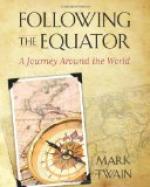They were lazy—always lazy. Perhaps that was their trouble. It is a killing defect. Surely they could have invented and built a competent house, but they didn’t. And they could have invented and developed the agricultural arts, but they didn’t. They went naked and houseless, and lived on fish and grubs and worms and wild fruits, and were just plain savages, for all their smartness.
With a country as big as the United States to live and multiply in, and with no epidemic diseases among them till the white man came with those and his other appliances of civilization, it is quite probable that there was never a day in his history when he could muster 100,000 of his race in all Australia. He diligently and deliberately kept population down by infanticide—largely; but mainly by certain other methods. He did not need to practise these artificialities any more after the white man came. The white man knew ways of keeping down population which were worth several of his. The white man knew ways of reducing a native population 80 percent. in 20 years. The native had never seen anything as fine as that before.
For example, there is the case of the country now called Victoria—a country eighty times as large as Rhode Island, as I have already said. By the best official guess there were 4,500 aboriginals in it when the whites came along in the middle of the ’Thirties. Of these, 1,000 lived in Gippsland, a patch of territory the size of fifteen or sixteen Rhode Islands: they did not diminish as fast as some of the other communities; indeed, at the end of forty years there were still 200 of them left. The Geelong tribe diminished more satisfactorily: from 173 persons it faded to 34 in twenty years; at the end of another twenty the tribe numbered one person altogether. The two Melbourne tribes could muster almost 300 when the white man came; they could muster but twenty, thirty-seven years later, in 1875. In that year there were still odds and ends of tribes scattered about the colony of Victoria, but I was told that natives of full blood are very scarce now. It is said that the aboriginals continue in some force in the huge territory called Queensland.
The early whites were not used to savages. They could not understand the primary law of savage life: that if a man do you a wrong, his whole tribe is responsible—each individual of it—and you may take your change out of any individual of it, without bothering to seek out the guilty one. When a white killed an aboriginal, the tribe applied the ancient law, and killed the first white they came across. To the whites this was a monstrous thing. Extermination seemed to be the proper medicine for such creatures as this. They did not kill all the blacks, but they promptly killed enough of them to make their own persons safe. From the dawn of civilization down to this day the white man has always used that very precaution. Mrs. Campbell Praed lived in Queensland, as a child, in the early days, and in her “Sketches of Australian life,” we get informing pictures of the early struggles of the white and the black to reform each other.




